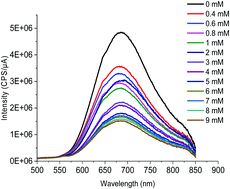Detecting lysozyme unfolding via the fluorescence of lysozyme encapsulated gold nanoclusters
Abstract
Protein misfolding plays a critical role in the manifestation of amyloidosis type diseases. Therefore, understanding protein unfolding and the ability to track protein unfolding in a dynamic manner are of considerable interest. Fluorescence-based techniques are powerful tools for gaining real-time information about the local environmental conditions of a probe on the nanoscale. Fluorescent gold nanoclusters (AuNCs) are a new type of fluorescent probes which are <2 nm in diameter, incredibly robust and offer highly sensitive, wavelength tuneable emission. Their small size minimises intrusion and makes AuNCs ideal for studying protein dynamics. Lysozyme has previously been used to encapsulate AuNCs. The unfolding dynamics of lysozyme under different environmental conditions have been well-studied and being an amyloid type protein makes lysozyme an ideal candidate for encapsulating AuNCs in order to test their sensitivity to protein unfolding. In this study, we tracked the fluorescence characteristics of AuNCs encapsulated in lysozyme while inducing protein unfolding using urea, sodium dodecyl sulphate (SDS) and elevated temperature and compared them to complimentary circular dichroism spectra. It is found that AuNC fluorescence emission is quenched upon induced protein unfolding either due to a decrease in Forster Resonance Energy Transfer (FRET) efficiency between tryptophan and AuNCs or solvent exposure of the AuNC. Fluorescence lifetime measurements confirmed quenching to be collisional via oxygen dissolved in a solution which increases as the AuNC was exposed to the solvent during unfolding. Moreover, the longer decay component τ1 was observed to decrease as the protein unfolded, due to the increased collisional quenching. It is suggested that AuNC sensitivity to solvent exposure might be utilised in the future as a new approach to studying and possibly even detecting amyloidosis type diseases.



 Please wait while we load your content...
Please wait while we load your content...